The new issue of the Surfcaster’s Journal Magazine is finished but unfortunately Tommy’s PC keeps crashing all week during the upload process. We are cautiously optimistic that it will be live tomorrow or Saturday
We sincerely apologize for this inconvenience
Zeno
This article has been adapted from “Doc” Muller’s Surf Fishing Annual, originally published in 1994. Doc’s publication served as our inspiration when we started the Surfcaster’s Journal Magazine. We are proud to feature this classic article by Doc Muller in past issue of the Surfcaster’s Journal Magazine and on our blog. It originally appeared in Volume 1 of the Surf Fishing Magazine.
ARTIFICIALS for BIG BASS
Patience and Discipline are Keys to a Trophy
By William A. “Doc” Muller
The quickest route to a trophy bass is to use bait, and I don’t think too many experts would disagree with this statement. However, many surf fisher people prefer artificials and want a sound plan that will put them into an out-sized bass using artificial baits. Oddly, for all the bait fishing I do, and I do a lot, the biggest bass I’ve caught using bait has been 35 pounds. The 53 pounder that graces the wall of my office was caught on an artificial. In fact, all the fifty pound class bass I’ve caught have been caught on artificial lures.
I share this with you so you’ll be confident that it is possible to catch very large bass on lures. However, there is a hitch. That is, you’ll likely work a lot harder at catching those monsters when you use lures as opposed to bait.
KEY FACTS
- BE PATIENT!
If you like lots of action, these techniques are not for you. Inevitably, lots of action involves small fish because there are so many more small fish than large ones.
- DON’T FISH AROUND SMALL FISH
Yes, big fish do swim with small fish, but the smaller fish are so much more aggressive that it becomes next to impossible to catch a big fish with a lure. One Halloween, my friend Brian and I were into a load of bass and blues that were running baby bunker up and down a beach all day. Finally, as the tide neared flood, the fish cornered a load of bunker against a jetty. It was cloudy and the water was gin clear. Brian climbed up on the jetty for a look see and his eyes almost popped out of his head. Mind you, the biggest bass we’d caught was 14 pounds.
“Bill, there’s a school of 30s and 40s lying on the sand! Throw your plug over here.”
I did as I was directed. Standing on the sand, I angled a cast towards the jetty and began cranking the plug down.
“Good! One’s coming off the bottom. Almost there. Keep reeling, almost on it. Damn!”
Brian’s play by play told me what my eyes could not see. Although the slower large bass were very interested in my 1 ounce plug, smaller fish beat the big fish to the plug every time. Just in case you’re wondering, we also tried big plugs, tins, and bucktails, but the results were the same.
Although it is quite possible to catch a big fish on a small bait, big lures discourage small fish and big bass are often angered by the noise and gaudy action of bigger lures and they will attack them. As you can tell from item #2, it isn’t a perfect world.
- BE DISCIPLINED
If you are unable to stay focused and make every cast count, cast after cast, hour after hour, then your presentation will be sloppy and your odds of fooling a trophy go way down. It takes discipline to concentrate thoroughly on what you’re doing when nothing is happening, but it is an essential ingredient for success. When, after two or three hours, a 45 pound bass wanders into the strike zone of your lure, two things must happen to be successful and catch that fish. One, the presentation must be perfect. Imperfections will cause a fish to either never become curious or lose interest sometime during the pursuit. Second, you must be ready for the hit so you can strike quickly and hard. The mouth of a big bass is tough and you’ll need very sharp hooks and a quick strong set to put the steel home.
I see so many anglers on our beaches who are under-gunned. They may have fun with the little fish, but the big ones give them and their tackle fits. Look, just because your rod is eleven feet doesn’t mean you’re automatically outfitted correctly. Rapid taper rods, so common everywhere, can not deliver big baits for distance, and they can’t drive even sharp hooks into tough jaws. If it’s a trophy you seek, please get a parabolic eleven foot rod that will allow you the opportunity to hook and land your trophy. While we’re at it, your reel and line must match the rod. I prefer Penn’s recently reintroduced 706Z because it is rugged, casts far, and is reasonably priced. The Daiwa BG 60 and BG 90 are also serviceable reels at a reasonable price. There’s also the Van Staal reel which is a precise instrument but costs up to $400. The Penn 850 SS is another solid surf reel. Please don’t use the 750 SS reel on an 11 foot rod because you’ll be under-gunned. Whatever the reel you use, fill the spool with 20 pound test line. Although you’ll gain some distance with 15 pound test over 20, it isn’t a lot of yards in the final analysis. However, what you’ll gain with 20 pound test line is the ability to really lean into a cast with a wind in your face, maintain a 7 or 8 pound drag with confidence, be able to make a solid hook set, and have some insurance against sharp gill plates, rocks, and shells. I like Berkley’s Big Game Line and Fenwick’s Salt Line.
FIVE GOOD LURES
There is almost an infinite variety of lures to choose from in today’s technologically oriented marketplace. However, technology doesn’t necessarily produce a better product, and some of the best lures available are traditional standbys. They work and are still around because they have never stopped catching fish.
SEVEN INCH REDFIN
I have been high on this lure for daytime big bassin’ for years. At first I thought I’d stumbled onto something that only I knew. However, the last few years I’ve watched fishing videos where others use this lure to catch big bass in fresh water at places like Norris Lake in Tennessee, the Chattahoochee River in Georgia, and Lake Cumberland in Kentucky. They use the lure the same way I do, catch bass, and have the same problems I do. The biggest problem with this lure is that you lose a lot of fish because of the way the fish rise to, then roll over, the plug when they hit. However folks, this minor drawback is offset by the fact that this lure will attract bass and trigger them to strike when nothing else will in daylight. Further, it will catch them when they are in a neutral or negative feeding stage. I am talking exclusively about the floating model of the lure. It should be retrieved so that it wiggles on the surface, leaving a V-shaped wake. The lure is not suitable for big wave water, but try it in sounds, bays, and inlets. You’ll like it!
BUCKTAILS
No one knows for sure how long bucktail lures have been used to catch fish, but I’ll bet the precursor of the modern bucktail has its roots in primitive society. Bucktails catch all species of predators in all kinds of water, and all over the world. However, they are not idiot lures. That is, you can’t just cast them out and reel in. They must be worked properly. The biggest mistake I see people make is they give the lure too much bouncing motion. A bucktail should flutter, not bounce, for best results. Simply twitch your wrist slightly from time to time. Most hits will come when the lure drops back an inch or so. If the bucktail bounces wildly you could actually spook a predator. The second biggest mistake I see involves the speed of retrieve. If you don’t lose at least some bucktails to rocks and clutter, then you aren’t fishing them properly. For peak effectiveness, a bucktail should be worked close to the bottom. Bucktails work best when there is some depth to the water such as in the inlet channels, under the light at Montauk, off jetty tips, and around bridges. Attach a strip of porkrind for added attraction and action.
METAL LIP SWIMMERS
This is another plug that requires reasonably calm water, so inlets, channels, bays, and sounds are appropriate places to try them. There are, however, calmer days when big bass chase big bait into the ocean wash or near it, and big metal lips will work great at those times.
Although you should feel comfortable adjusting the eye of the plug up and down, don’t bend the lip. Only very experienced surf fishermen can get away with doing this. Most often a bent lip renders a metal lip useless. Bend the front eye down to get the plug to ride higher, and bend it up to get the plug to dig deeper into the water. There’s a time and a place for both. Calm water in daylight, it seems to me, is the right time for a surface swimming plug. On the other hand, night time with some wave action seems to suggest we get the plug a little deeper. Big metal lip plugs like the Atom 40, Atom Junior, Danny Plugs, Larry’s Lures, and Bob Hahn plugs are quality products. Incidentally, metal lip swimmers are the best choice for making an eel skin plug. More about that another time.
These two types of swimming plugs are ideal for rough water and rip fishing. For that reason they have been mainstays at Montauk for years. They cast well and “bite” well. That is, they catch the water well enough so that even the rise and fall of waves doesn’t stop their action. In order to get the most out of them in rough water, stay in touch with the plug at all times. That is, increase and decrease the speed of retrieve as the waves push and pull on the plug so that the plug works at the same speed at all times. In a rip, cast out and retrieve slowly. These big plugs can be used to tempt a trophy at any beach and under any type of water conditions. These plugs should be in your bag at all times from September 1 until the end of the season. Old reliable models such as the Gibbs and Super Strike brands are excellent choices and they have caught a lot of big fish over the years. I recently helped develop and test a new breed of lures called Strike Maker, and this line includes the Throttle Bottle.
Believe it or not this is the entire recipe for catching a trophy bass on an artificial, the rest is up to you. Remember, there are no secrets spots or secret lures. All the lures I’ve discussed will catch a wall hanger, but only if you supply the most important ingredient of all. You must not only put your time in, but you must invest a lot of time with discipline, focus, and patience. Hey, if you do catch one, think about letting it go to fight another day. I can tell you from experience, it burns a life-long memory into your brain.
Bill “Doc” Muller is one of the most dedicated and successful surf fishermen on the east coast. He is also an accomplished author, publisher, editor, and lecturer. He was a college professor of biology for 35 years and recently retired. Doc joined the High Hill Striper Club in the early 1970s and was a member until 2001 when he, along with six other surf anglers, founded the Traditional Surfcasters, a club committed to preserving the philosophy of newly redefined post WW II surf fishing.

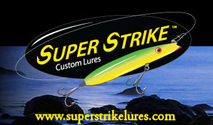

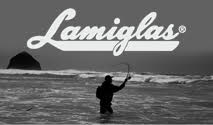


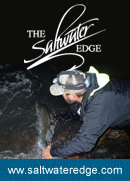




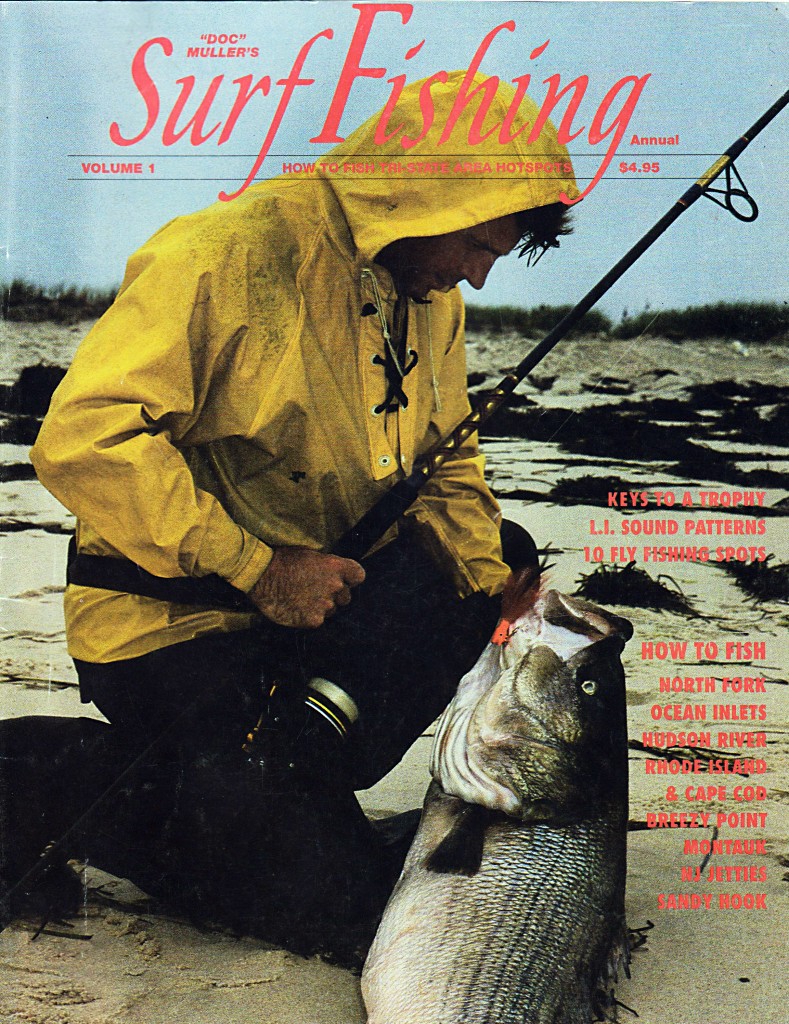


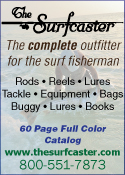


Good read psyched me up for this season
↓I wish Van Staals were still $400!
↓Great read, Doc is an awesome speaker and author.
Man look at those young faces!! Where the heck does the time go.. Thanks for the post Z!
↓I remember that issue. Not one of Golofaro’s better mug shots 😉
↓I still have those magazines. Who else? I only wish I could still order a Coastal bag.
↓Thanks. Yes, good read.
↓good read thanks for sharing
↓